Comprehensive Analysis of Brand Management for Audi and Hyundai
VerifiedAdded on 2020/06/04
|18
|5585
|55
Report
AI Summary
This report provides a comprehensive analysis of brand management strategies, focusing on the automotive industry with case studies of Audi and Hyundai. It delves into the significance of branding as a marketing tool, exploring how brands establish themselves and maintain a strong presence in the market. The report outlines key components of successful brand strategies, including brand reinforcement and revitalization, as well as portfolio management techniques. It further examines brand hierarchy and brand equity management, offering insights into how companies like Audi and Hyundai manage their brand value and navigate collaborations and partnerships at both global and domestic levels. Finally, the report discusses various techniques for managing and measuring brand value, offering a holistic view of brand management in the competitive automotive landscape. The report highlights the importance of creating a positive brand image, building customer loyalty, and adapting to dynamic market changes to sustain business growth and market share.
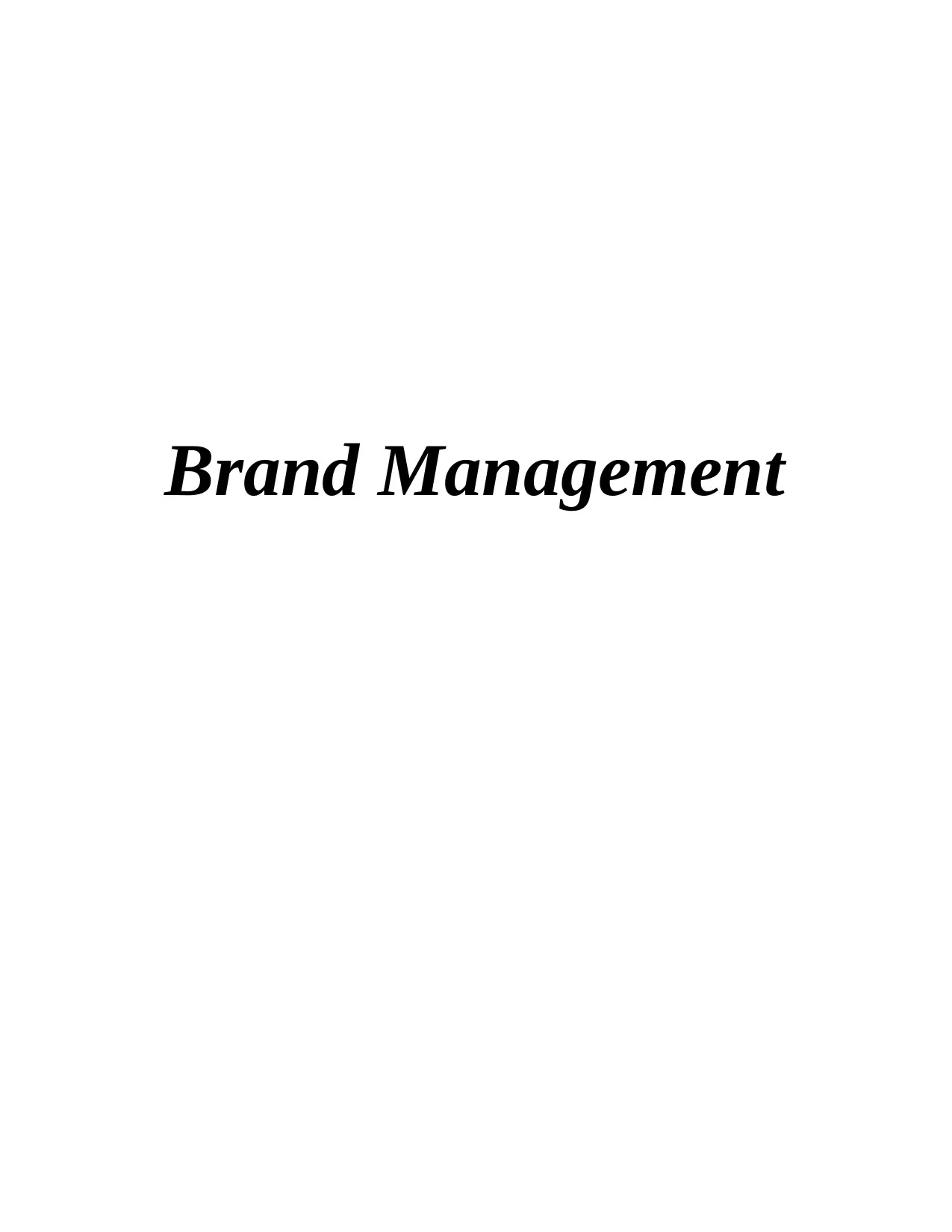
Brand Management
Paraphrase This Document
Need a fresh take? Get an instant paraphrase of this document with our AI Paraphraser
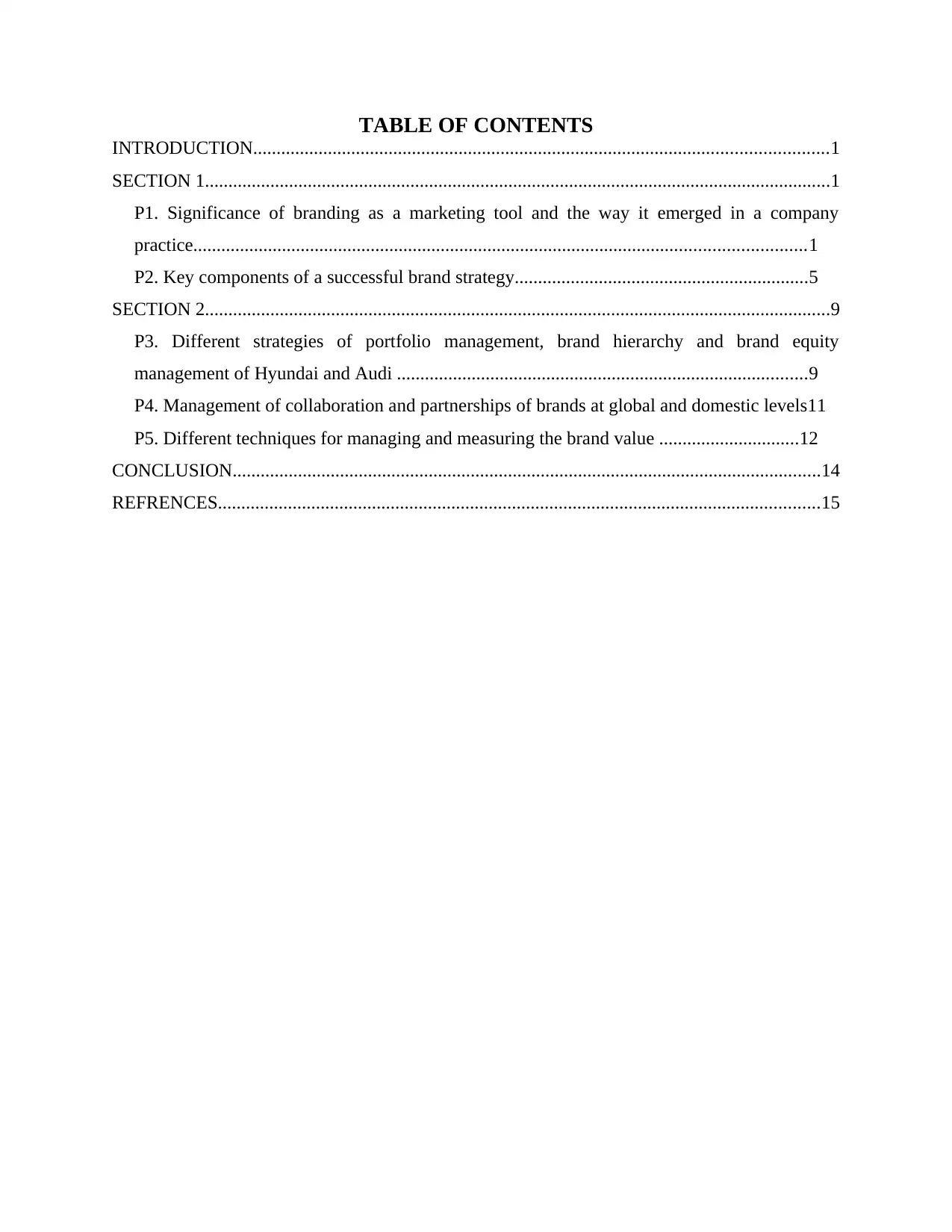
TABLE OF CONTENTS
INTRODUCTION...........................................................................................................................1
SECTION 1......................................................................................................................................1
P1. Significance of branding as a marketing tool and the way it emerged in a company
practice...................................................................................................................................1
P2. Key components of a successful brand strategy...............................................................5
SECTION 2......................................................................................................................................9
P3. Different strategies of portfolio management, brand hierarchy and brand equity
management of Hyundai and Audi ........................................................................................9
P4. Management of collaboration and partnerships of brands at global and domestic levels11
P5. Different techniques for managing and measuring the brand value ..............................12
CONCLUSION..............................................................................................................................14
REFRENCES.................................................................................................................................15
INTRODUCTION...........................................................................................................................1
SECTION 1......................................................................................................................................1
P1. Significance of branding as a marketing tool and the way it emerged in a company
practice...................................................................................................................................1
P2. Key components of a successful brand strategy...............................................................5
SECTION 2......................................................................................................................................9
P3. Different strategies of portfolio management, brand hierarchy and brand equity
management of Hyundai and Audi ........................................................................................9
P4. Management of collaboration and partnerships of brands at global and domestic levels11
P5. Different techniques for managing and measuring the brand value ..............................12
CONCLUSION..............................................................................................................................14
REFRENCES.................................................................................................................................15
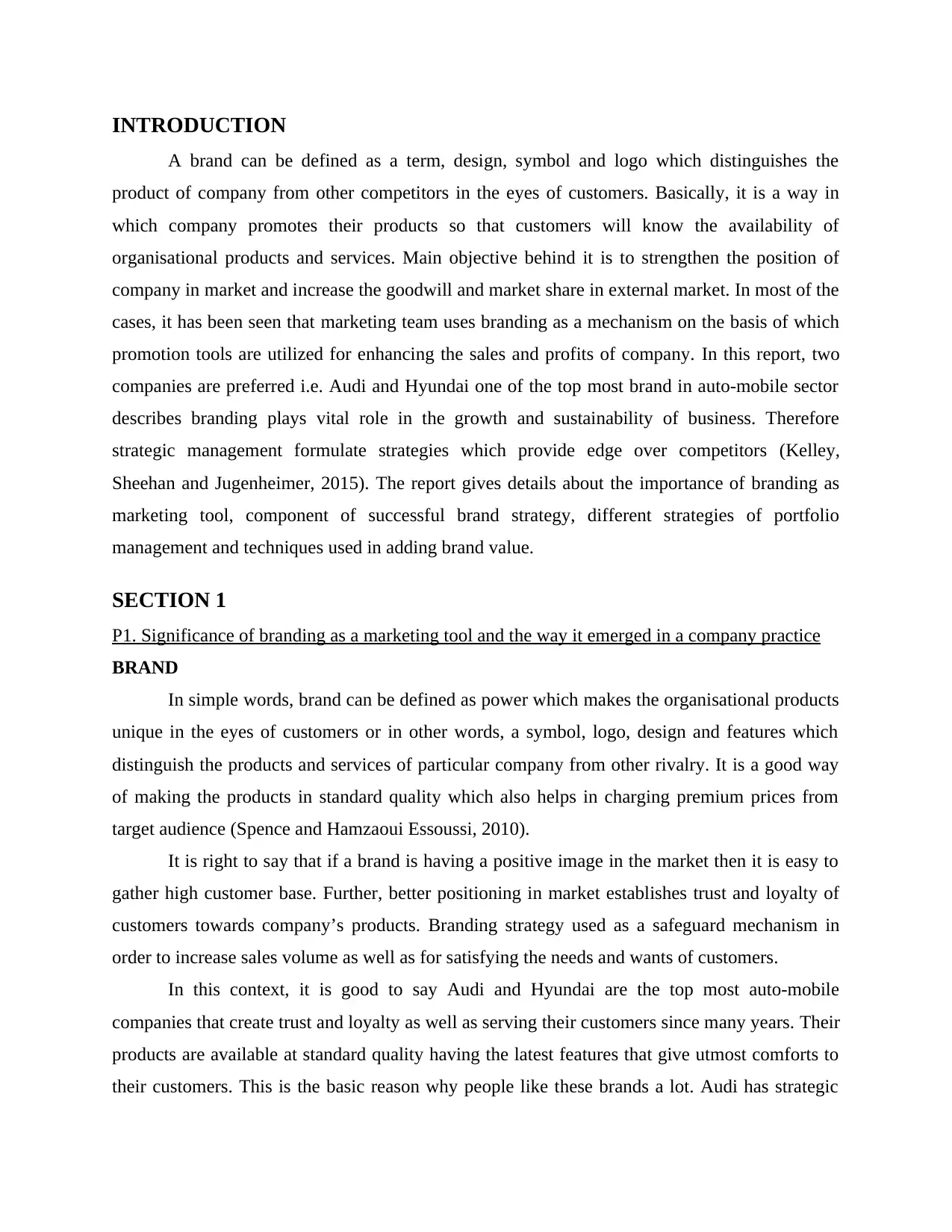
INTRODUCTION
A brand can be defined as a term, design, symbol and logo which distinguishes the
product of company from other competitors in the eyes of customers. Basically, it is a way in
which company promotes their products so that customers will know the availability of
organisational products and services. Main objective behind it is to strengthen the position of
company in market and increase the goodwill and market share in external market. In most of the
cases, it has been seen that marketing team uses branding as a mechanism on the basis of which
promotion tools are utilized for enhancing the sales and profits of company. In this report, two
companies are preferred i.e. Audi and Hyundai one of the top most brand in auto-mobile sector
describes branding plays vital role in the growth and sustainability of business. Therefore
strategic management formulate strategies which provide edge over competitors (Kelley,
Sheehan and Jugenheimer, 2015). The report gives details about the importance of branding as
marketing tool, component of successful brand strategy, different strategies of portfolio
management and techniques used in adding brand value.
SECTION 1
P1. Significance of branding as a marketing tool and the way it emerged in a company practice
BRAND
In simple words, brand can be defined as power which makes the organisational products
unique in the eyes of customers or in other words, a symbol, logo, design and features which
distinguish the products and services of particular company from other rivalry. It is a good way
of making the products in standard quality which also helps in charging premium prices from
target audience (Spence and Hamzaoui Essoussi, 2010).
It is right to say that if a brand is having a positive image in the market then it is easy to
gather high customer base. Further, better positioning in market establishes trust and loyalty of
customers towards company’s products. Branding strategy used as a safeguard mechanism in
order to increase sales volume as well as for satisfying the needs and wants of customers.
In this context, it is good to say Audi and Hyundai are the top most auto-mobile
companies that create trust and loyalty as well as serving their customers since many years. Their
products are available at standard quality having the latest features that give utmost comforts to
their customers. This is the basic reason why people like these brands a lot. Audi has strategic
A brand can be defined as a term, design, symbol and logo which distinguishes the
product of company from other competitors in the eyes of customers. Basically, it is a way in
which company promotes their products so that customers will know the availability of
organisational products and services. Main objective behind it is to strengthen the position of
company in market and increase the goodwill and market share in external market. In most of the
cases, it has been seen that marketing team uses branding as a mechanism on the basis of which
promotion tools are utilized for enhancing the sales and profits of company. In this report, two
companies are preferred i.e. Audi and Hyundai one of the top most brand in auto-mobile sector
describes branding plays vital role in the growth and sustainability of business. Therefore
strategic management formulate strategies which provide edge over competitors (Kelley,
Sheehan and Jugenheimer, 2015). The report gives details about the importance of branding as
marketing tool, component of successful brand strategy, different strategies of portfolio
management and techniques used in adding brand value.
SECTION 1
P1. Significance of branding as a marketing tool and the way it emerged in a company practice
BRAND
In simple words, brand can be defined as power which makes the organisational products
unique in the eyes of customers or in other words, a symbol, logo, design and features which
distinguish the products and services of particular company from other rivalry. It is a good way
of making the products in standard quality which also helps in charging premium prices from
target audience (Spence and Hamzaoui Essoussi, 2010).
It is right to say that if a brand is having a positive image in the market then it is easy to
gather high customer base. Further, better positioning in market establishes trust and loyalty of
customers towards company’s products. Branding strategy used as a safeguard mechanism in
order to increase sales volume as well as for satisfying the needs and wants of customers.
In this context, it is good to say Audi and Hyundai are the top most auto-mobile
companies that create trust and loyalty as well as serving their customers since many years. Their
products are available at standard quality having the latest features that give utmost comforts to
their customers. This is the basic reason why people like these brands a lot. Audi has strategic
⊘ This is a preview!⊘
Do you want full access?
Subscribe today to unlock all pages.

Trusted by 1+ million students worldwide
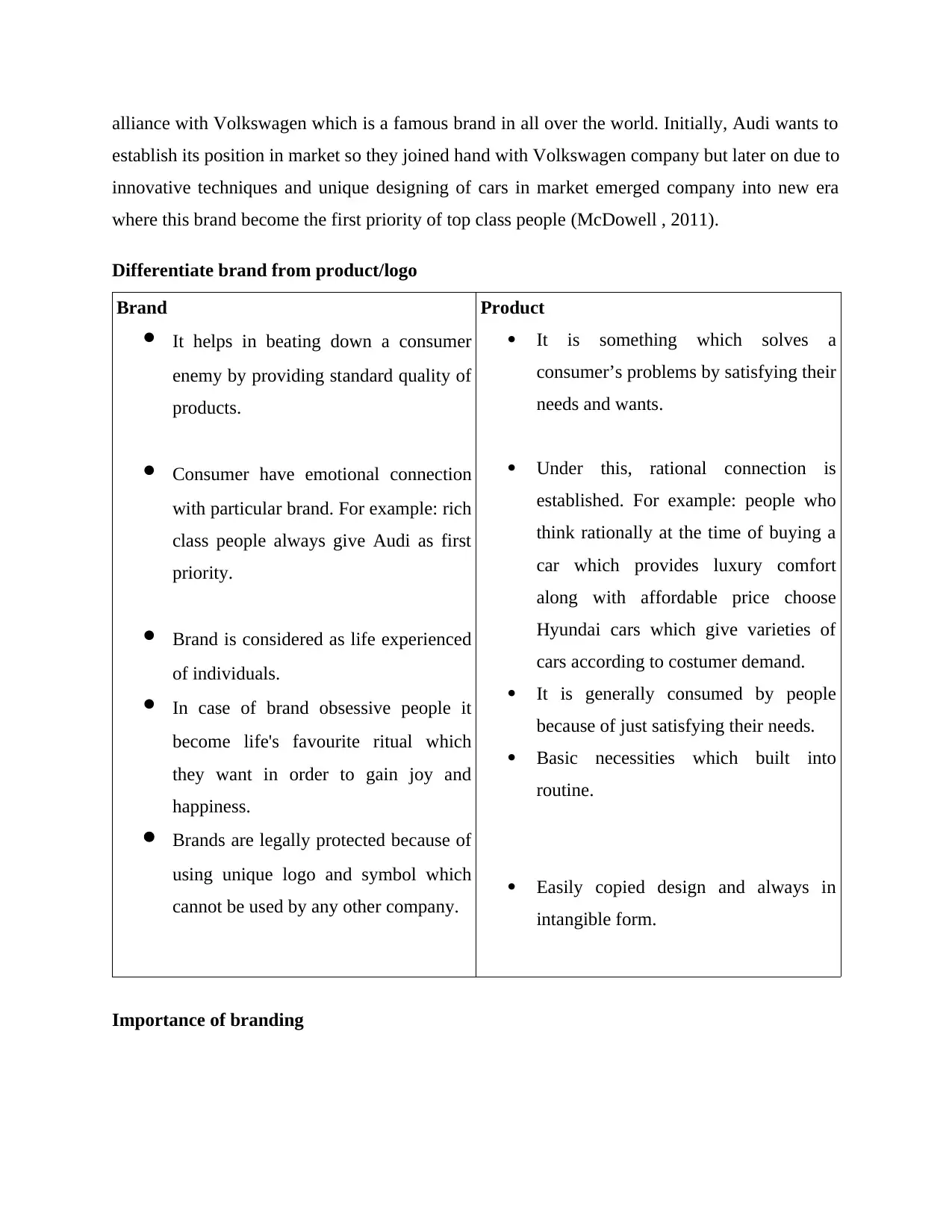
alliance with Volkswagen which is a famous brand in all over the world. Initially, Audi wants to
establish its position in market so they joined hand with Volkswagen company but later on due to
innovative techniques and unique designing of cars in market emerged company into new era
where this brand become the first priority of top class people (McDowell , 2011).
Differentiate brand from product/logo
Brand
It helps in beating down a consumer
enemy by providing standard quality of
products.
Consumer have emotional connection
with particular brand. For example: rich
class people always give Audi as first
priority.
Brand is considered as life experienced
of individuals.
In case of brand obsessive people it
become life's favourite ritual which
they want in order to gain joy and
happiness.
Brands are legally protected because of
using unique logo and symbol which
cannot be used by any other company.
Product
It is something which solves a
consumer’s problems by satisfying their
needs and wants.
Under this, rational connection is
established. For example: people who
think rationally at the time of buying a
car which provides luxury comfort
along with affordable price choose
Hyundai cars which give varieties of
cars according to costumer demand.
It is generally consumed by people
because of just satisfying their needs.
Basic necessities which built into
routine.
Easily copied design and always in
intangible form.
Importance of branding
establish its position in market so they joined hand with Volkswagen company but later on due to
innovative techniques and unique designing of cars in market emerged company into new era
where this brand become the first priority of top class people (McDowell , 2011).
Differentiate brand from product/logo
Brand
It helps in beating down a consumer
enemy by providing standard quality of
products.
Consumer have emotional connection
with particular brand. For example: rich
class people always give Audi as first
priority.
Brand is considered as life experienced
of individuals.
In case of brand obsessive people it
become life's favourite ritual which
they want in order to gain joy and
happiness.
Brands are legally protected because of
using unique logo and symbol which
cannot be used by any other company.
Product
It is something which solves a
consumer’s problems by satisfying their
needs and wants.
Under this, rational connection is
established. For example: people who
think rationally at the time of buying a
car which provides luxury comfort
along with affordable price choose
Hyundai cars which give varieties of
cars according to costumer demand.
It is generally consumed by people
because of just satisfying their needs.
Basic necessities which built into
routine.
Easily copied design and always in
intangible form.
Importance of branding
Paraphrase This Document
Need a fresh take? Get an instant paraphrase of this document with our AI Paraphraser
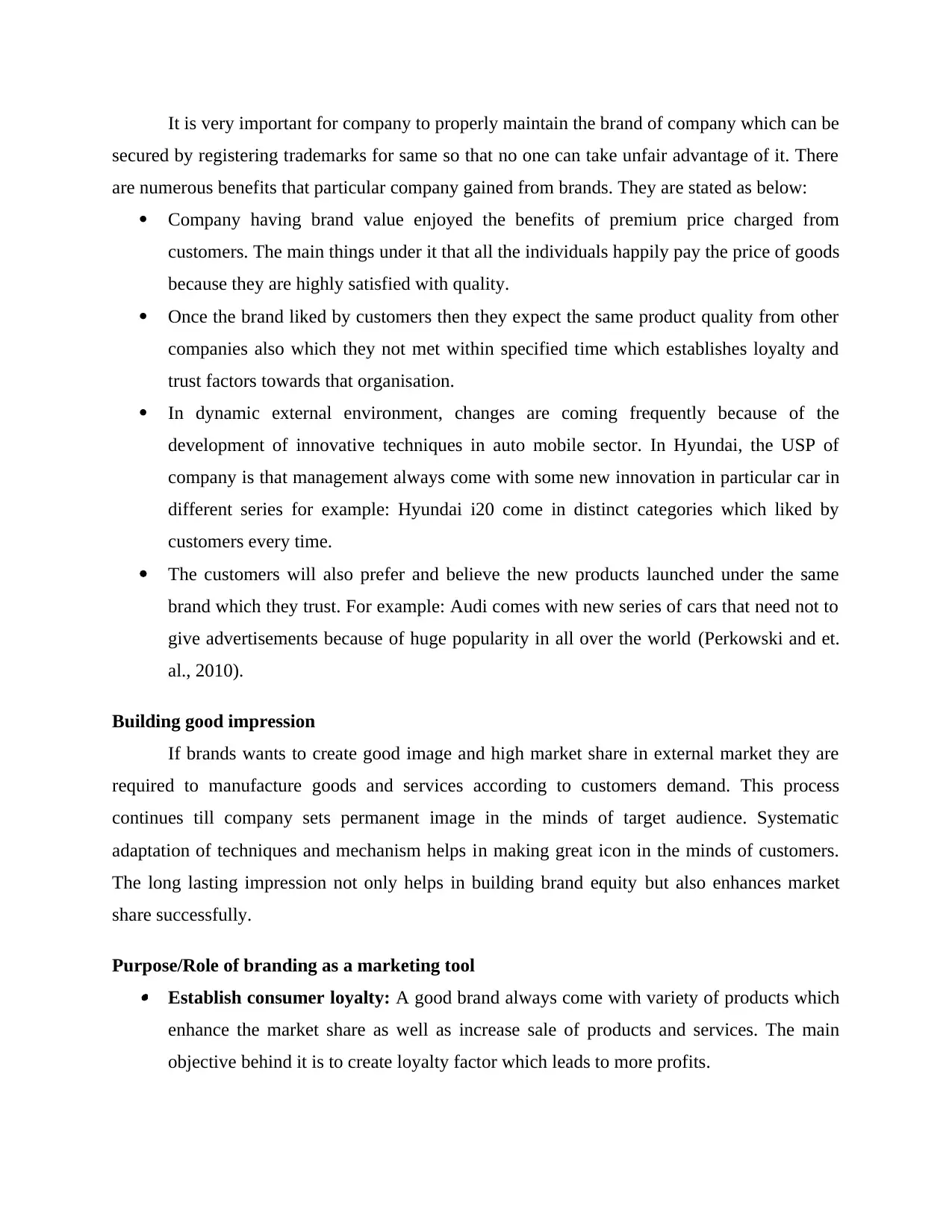
It is very important for company to properly maintain the brand of company which can be
secured by registering trademarks for same so that no one can take unfair advantage of it. There
are numerous benefits that particular company gained from brands. They are stated as below:
Company having brand value enjoyed the benefits of premium price charged from
customers. The main things under it that all the individuals happily pay the price of goods
because they are highly satisfied with quality.
Once the brand liked by customers then they expect the same product quality from other
companies also which they not met within specified time which establishes loyalty and
trust factors towards that organisation.
In dynamic external environment, changes are coming frequently because of the
development of innovative techniques in auto mobile sector. In Hyundai, the USP of
company is that management always come with some new innovation in particular car in
different series for example: Hyundai i20 come in distinct categories which liked by
customers every time.
The customers will also prefer and believe the new products launched under the same
brand which they trust. For example: Audi comes with new series of cars that need not to
give advertisements because of huge popularity in all over the world (Perkowski and et.
al., 2010).
Building good impression
If brands wants to create good image and high market share in external market they are
required to manufacture goods and services according to customers demand. This process
continues till company sets permanent image in the minds of target audience. Systematic
adaptation of techniques and mechanism helps in making great icon in the minds of customers.
The long lasting impression not only helps in building brand equity but also enhances market
share successfully.
Purpose/Role of branding as a marketing tool Establish consumer loyalty: A good brand always come with variety of products which
enhance the market share as well as increase sale of products and services. The main
objective behind it is to create loyalty factor which leads to more profits.
secured by registering trademarks for same so that no one can take unfair advantage of it. There
are numerous benefits that particular company gained from brands. They are stated as below:
Company having brand value enjoyed the benefits of premium price charged from
customers. The main things under it that all the individuals happily pay the price of goods
because they are highly satisfied with quality.
Once the brand liked by customers then they expect the same product quality from other
companies also which they not met within specified time which establishes loyalty and
trust factors towards that organisation.
In dynamic external environment, changes are coming frequently because of the
development of innovative techniques in auto mobile sector. In Hyundai, the USP of
company is that management always come with some new innovation in particular car in
different series for example: Hyundai i20 come in distinct categories which liked by
customers every time.
The customers will also prefer and believe the new products launched under the same
brand which they trust. For example: Audi comes with new series of cars that need not to
give advertisements because of huge popularity in all over the world (Perkowski and et.
al., 2010).
Building good impression
If brands wants to create good image and high market share in external market they are
required to manufacture goods and services according to customers demand. This process
continues till company sets permanent image in the minds of target audience. Systematic
adaptation of techniques and mechanism helps in making great icon in the minds of customers.
The long lasting impression not only helps in building brand equity but also enhances market
share successfully.
Purpose/Role of branding as a marketing tool Establish consumer loyalty: A good brand always come with variety of products which
enhance the market share as well as increase sale of products and services. The main
objective behind it is to create loyalty factor which leads to more profits.
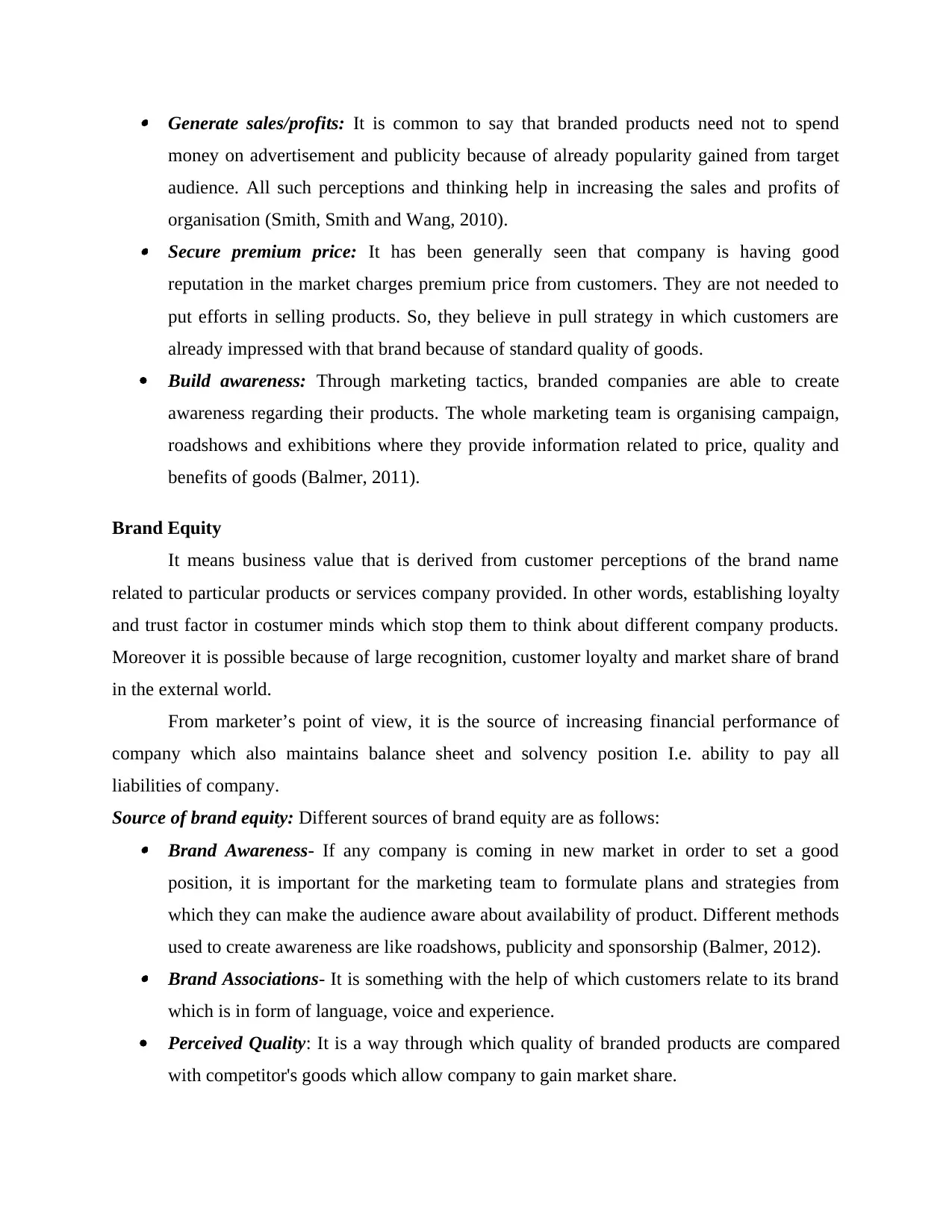
Generate sales/profits: It is common to say that branded products need not to spend
money on advertisement and publicity because of already popularity gained from target
audience. All such perceptions and thinking help in increasing the sales and profits of
organisation (Smith, Smith and Wang, 2010). Secure premium price: It has been generally seen that company is having good
reputation in the market charges premium price from customers. They are not needed to
put efforts in selling products. So, they believe in pull strategy in which customers are
already impressed with that brand because of standard quality of goods.
Build awareness: Through marketing tactics, branded companies are able to create
awareness regarding their products. The whole marketing team is organising campaign,
roadshows and exhibitions where they provide information related to price, quality and
benefits of goods (Balmer, 2011).
Brand Equity
It means business value that is derived from customer perceptions of the brand name
related to particular products or services company provided. In other words, establishing loyalty
and trust factor in costumer minds which stop them to think about different company products.
Moreover it is possible because of large recognition, customer loyalty and market share of brand
in the external world.
From marketer’s point of view, it is the source of increasing financial performance of
company which also maintains balance sheet and solvency position I.e. ability to pay all
liabilities of company.
Source of brand equity: Different sources of brand equity are as follows: Brand Awareness- If any company is coming in new market in order to set a good
position, it is important for the marketing team to formulate plans and strategies from
which they can make the audience aware about availability of product. Different methods
used to create awareness are like roadshows, publicity and sponsorship (Balmer, 2012). Brand Associations- It is something with the help of which customers relate to its brand
which is in form of language, voice and experience.
Perceived Quality: It is a way through which quality of branded products are compared
with competitor's goods which allow company to gain market share.
money on advertisement and publicity because of already popularity gained from target
audience. All such perceptions and thinking help in increasing the sales and profits of
organisation (Smith, Smith and Wang, 2010). Secure premium price: It has been generally seen that company is having good
reputation in the market charges premium price from customers. They are not needed to
put efforts in selling products. So, they believe in pull strategy in which customers are
already impressed with that brand because of standard quality of goods.
Build awareness: Through marketing tactics, branded companies are able to create
awareness regarding their products. The whole marketing team is organising campaign,
roadshows and exhibitions where they provide information related to price, quality and
benefits of goods (Balmer, 2011).
Brand Equity
It means business value that is derived from customer perceptions of the brand name
related to particular products or services company provided. In other words, establishing loyalty
and trust factor in costumer minds which stop them to think about different company products.
Moreover it is possible because of large recognition, customer loyalty and market share of brand
in the external world.
From marketer’s point of view, it is the source of increasing financial performance of
company which also maintains balance sheet and solvency position I.e. ability to pay all
liabilities of company.
Source of brand equity: Different sources of brand equity are as follows: Brand Awareness- If any company is coming in new market in order to set a good
position, it is important for the marketing team to formulate plans and strategies from
which they can make the audience aware about availability of product. Different methods
used to create awareness are like roadshows, publicity and sponsorship (Balmer, 2012). Brand Associations- It is something with the help of which customers relate to its brand
which is in form of language, voice and experience.
Perceived Quality: It is a way through which quality of branded products are compared
with competitor's goods which allow company to gain market share.
⊘ This is a preview!⊘
Do you want full access?
Subscribe today to unlock all pages.

Trusted by 1+ million students worldwide
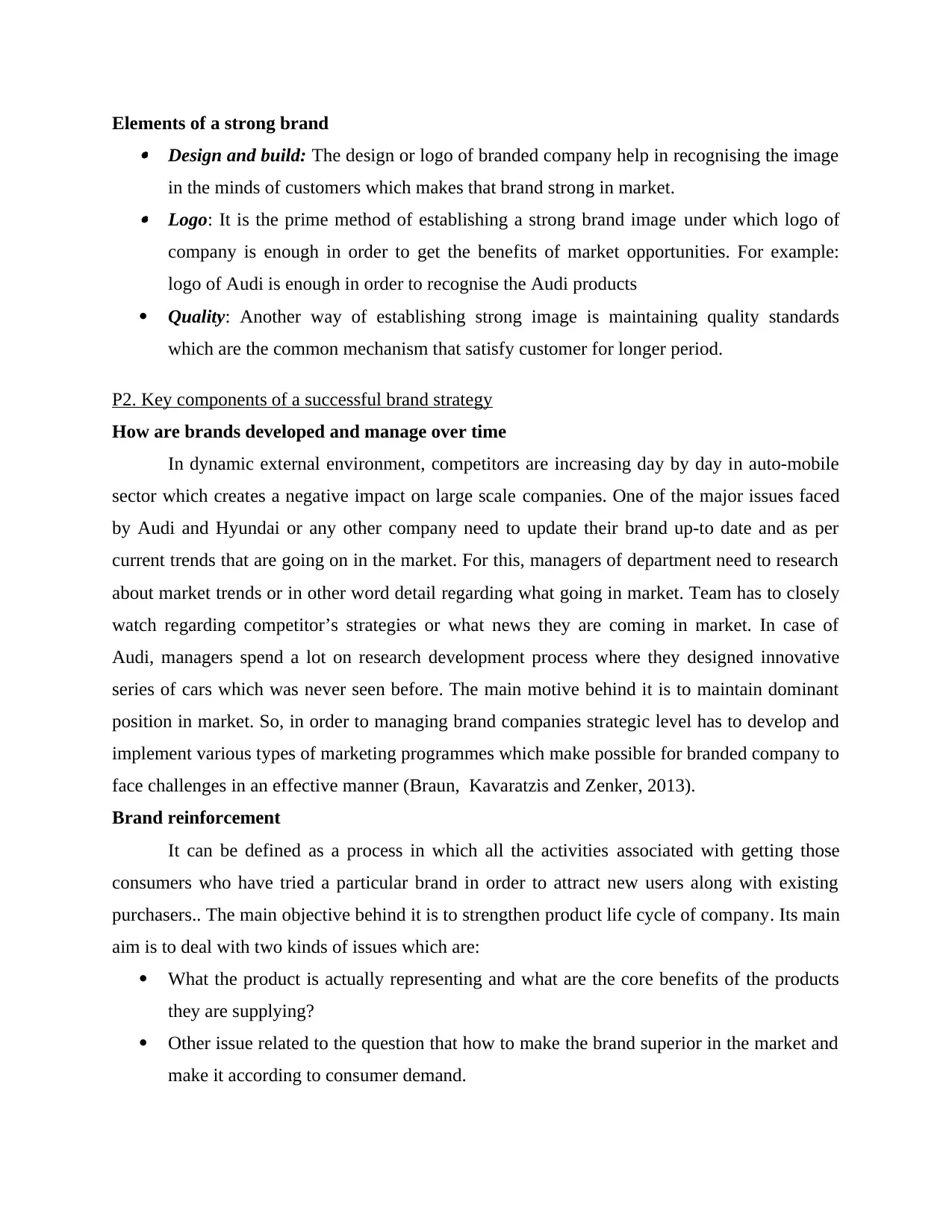
Elements of a strong brand Design and build: The design or logo of branded company help in recognising the image
in the minds of customers which makes that brand strong in market. Logo: It is the prime method of establishing a strong brand image under which logo of
company is enough in order to get the benefits of market opportunities. For example:
logo of Audi is enough in order to recognise the Audi products
Quality: Another way of establishing strong image is maintaining quality standards
which are the common mechanism that satisfy customer for longer period.
P2. Key components of a successful brand strategy
How are brands developed and manage over time
In dynamic external environment, competitors are increasing day by day in auto-mobile
sector which creates a negative impact on large scale companies. One of the major issues faced
by Audi and Hyundai or any other company need to update their brand up-to date and as per
current trends that are going on in the market. For this, managers of department need to research
about market trends or in other word detail regarding what going in market. Team has to closely
watch regarding competitor’s strategies or what news they are coming in market. In case of
Audi, managers spend a lot on research development process where they designed innovative
series of cars which was never seen before. The main motive behind it is to maintain dominant
position in market. So, in order to managing brand companies strategic level has to develop and
implement various types of marketing programmes which make possible for branded company to
face challenges in an effective manner (Braun, Kavaratzis and Zenker, 2013).
Brand reinforcement
It can be defined as a process in which all the activities associated with getting those
consumers who have tried a particular brand in order to attract new users along with existing
purchasers.. The main objective behind it is to strengthen product life cycle of company. Its main
aim is to deal with two kinds of issues which are:
What the product is actually representing and what are the core benefits of the products
they are supplying?
Other issue related to the question that how to make the brand superior in the market and
make it according to consumer demand.
in the minds of customers which makes that brand strong in market. Logo: It is the prime method of establishing a strong brand image under which logo of
company is enough in order to get the benefits of market opportunities. For example:
logo of Audi is enough in order to recognise the Audi products
Quality: Another way of establishing strong image is maintaining quality standards
which are the common mechanism that satisfy customer for longer period.
P2. Key components of a successful brand strategy
How are brands developed and manage over time
In dynamic external environment, competitors are increasing day by day in auto-mobile
sector which creates a negative impact on large scale companies. One of the major issues faced
by Audi and Hyundai or any other company need to update their brand up-to date and as per
current trends that are going on in the market. For this, managers of department need to research
about market trends or in other word detail regarding what going in market. Team has to closely
watch regarding competitor’s strategies or what news they are coming in market. In case of
Audi, managers spend a lot on research development process where they designed innovative
series of cars which was never seen before. The main motive behind it is to maintain dominant
position in market. So, in order to managing brand companies strategic level has to develop and
implement various types of marketing programmes which make possible for branded company to
face challenges in an effective manner (Braun, Kavaratzis and Zenker, 2013).
Brand reinforcement
It can be defined as a process in which all the activities associated with getting those
consumers who have tried a particular brand in order to attract new users along with existing
purchasers.. The main objective behind it is to strengthen product life cycle of company. Its main
aim is to deal with two kinds of issues which are:
What the product is actually representing and what are the core benefits of the products
they are supplying?
Other issue related to the question that how to make the brand superior in the market and
make it according to consumer demand.
Paraphrase This Document
Need a fresh take? Get an instant paraphrase of this document with our AI Paraphraser
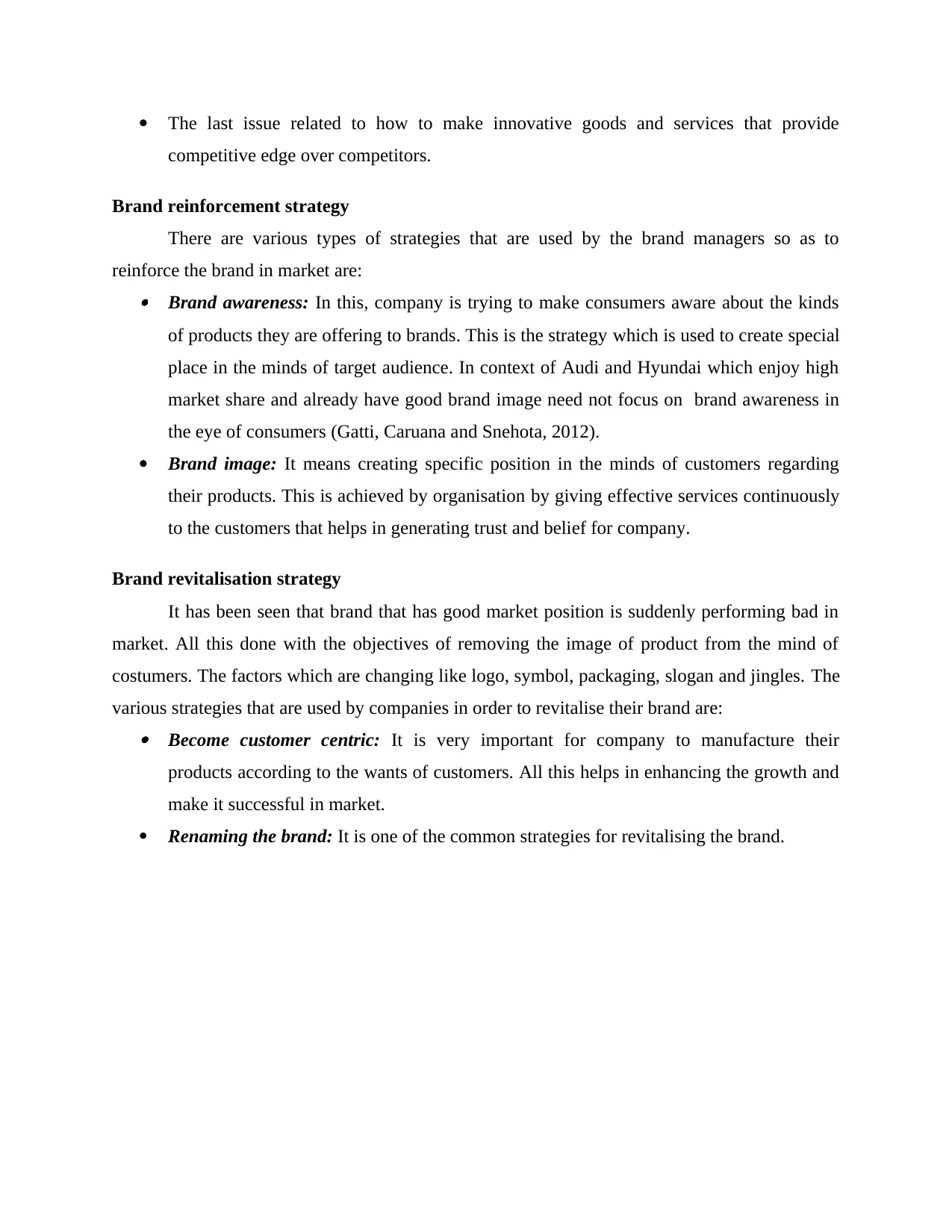
The last issue related to how to make innovative goods and services that provide
competitive edge over competitors.
Brand reinforcement strategy
There are various types of strategies that are used by the brand managers so as to
reinforce the brand in market are: Brand awareness: In this, company is trying to make consumers aware about the kinds
of products they are offering to brands. This is the strategy which is used to create special
place in the minds of target audience. In context of Audi and Hyundai which enjoy high
market share and already have good brand image need not focus on brand awareness in
the eye of consumers (Gatti, Caruana and Snehota, 2012).
Brand image: It means creating specific position in the minds of customers regarding
their products. This is achieved by organisation by giving effective services continuously
to the customers that helps in generating trust and belief for company.
Brand revitalisation strategy
It has been seen that brand that has good market position is suddenly performing bad in
market. All this done with the objectives of removing the image of product from the mind of
costumers. The factors which are changing like logo, symbol, packaging, slogan and jingles. The
various strategies that are used by companies in order to revitalise their brand are: Become customer centric: It is very important for company to manufacture their
products according to the wants of customers. All this helps in enhancing the growth and
make it successful in market.
Renaming the brand: It is one of the common strategies for revitalising the brand.
competitive edge over competitors.
Brand reinforcement strategy
There are various types of strategies that are used by the brand managers so as to
reinforce the brand in market are: Brand awareness: In this, company is trying to make consumers aware about the kinds
of products they are offering to brands. This is the strategy which is used to create special
place in the minds of target audience. In context of Audi and Hyundai which enjoy high
market share and already have good brand image need not focus on brand awareness in
the eye of consumers (Gatti, Caruana and Snehota, 2012).
Brand image: It means creating specific position in the minds of customers regarding
their products. This is achieved by organisation by giving effective services continuously
to the customers that helps in generating trust and belief for company.
Brand revitalisation strategy
It has been seen that brand that has good market position is suddenly performing bad in
market. All this done with the objectives of removing the image of product from the mind of
costumers. The factors which are changing like logo, symbol, packaging, slogan and jingles. The
various strategies that are used by companies in order to revitalise their brand are: Become customer centric: It is very important for company to manufacture their
products according to the wants of customers. All this helps in enhancing the growth and
make it successful in market.
Renaming the brand: It is one of the common strategies for revitalising the brand.
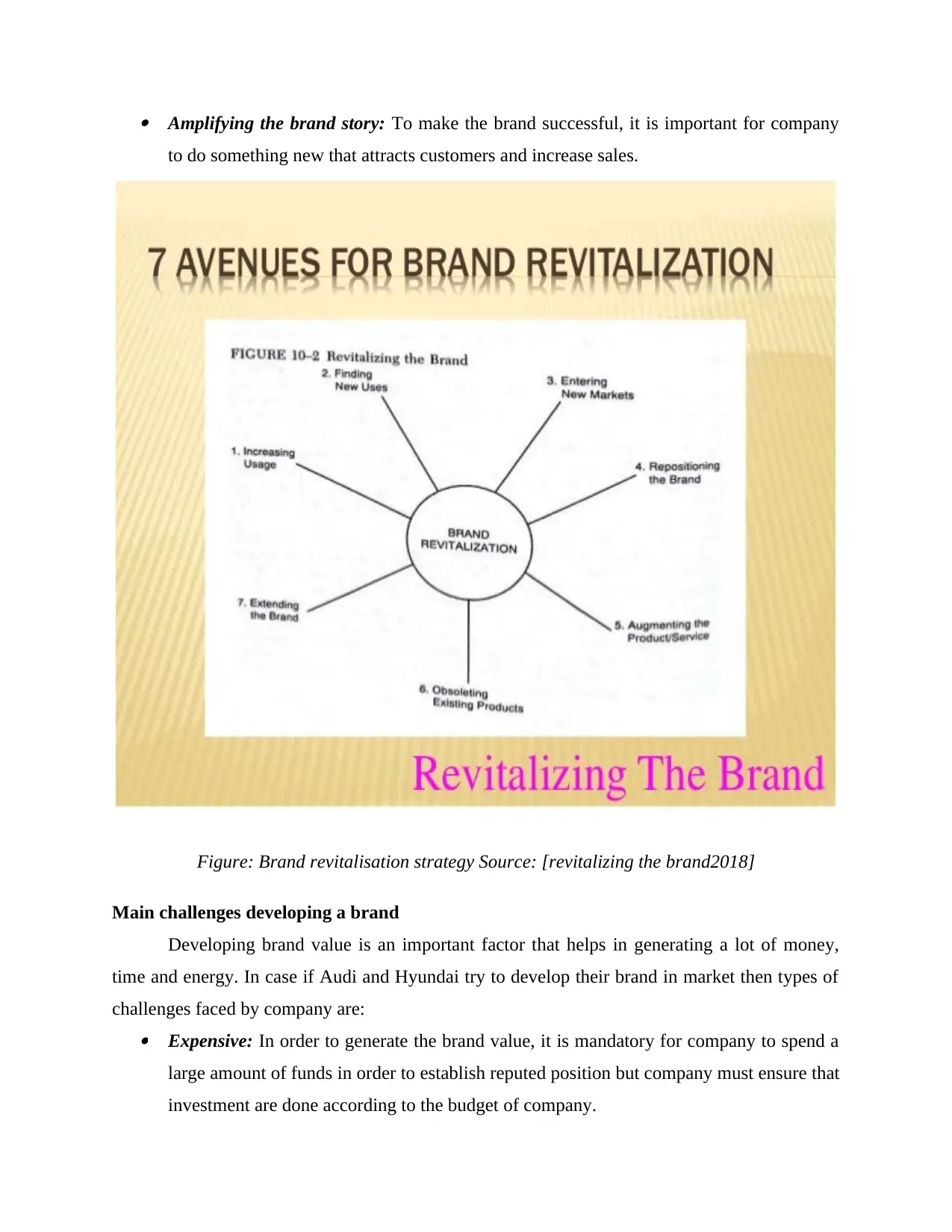
Amplifying the brand story: To make the brand successful, it is important for company
to do something new that attracts customers and increase sales.
Figure: Brand revitalisation strategy Source: [revitalizing the brand2018]
Main challenges developing a brand
Developing brand value is an important factor that helps in generating a lot of money,
time and energy. In case if Audi and Hyundai try to develop their brand in market then types of
challenges faced by company are: Expensive: In order to generate the brand value, it is mandatory for company to spend a
large amount of funds in order to establish reputed position but company must ensure that
investment are done according to the budget of company.
to do something new that attracts customers and increase sales.
Figure: Brand revitalisation strategy Source: [revitalizing the brand2018]
Main challenges developing a brand
Developing brand value is an important factor that helps in generating a lot of money,
time and energy. In case if Audi and Hyundai try to develop their brand in market then types of
challenges faced by company are: Expensive: In order to generate the brand value, it is mandatory for company to spend a
large amount of funds in order to establish reputed position but company must ensure that
investment are done according to the budget of company.
⊘ This is a preview!⊘
Do you want full access?
Subscribe today to unlock all pages.

Trusted by 1+ million students worldwide
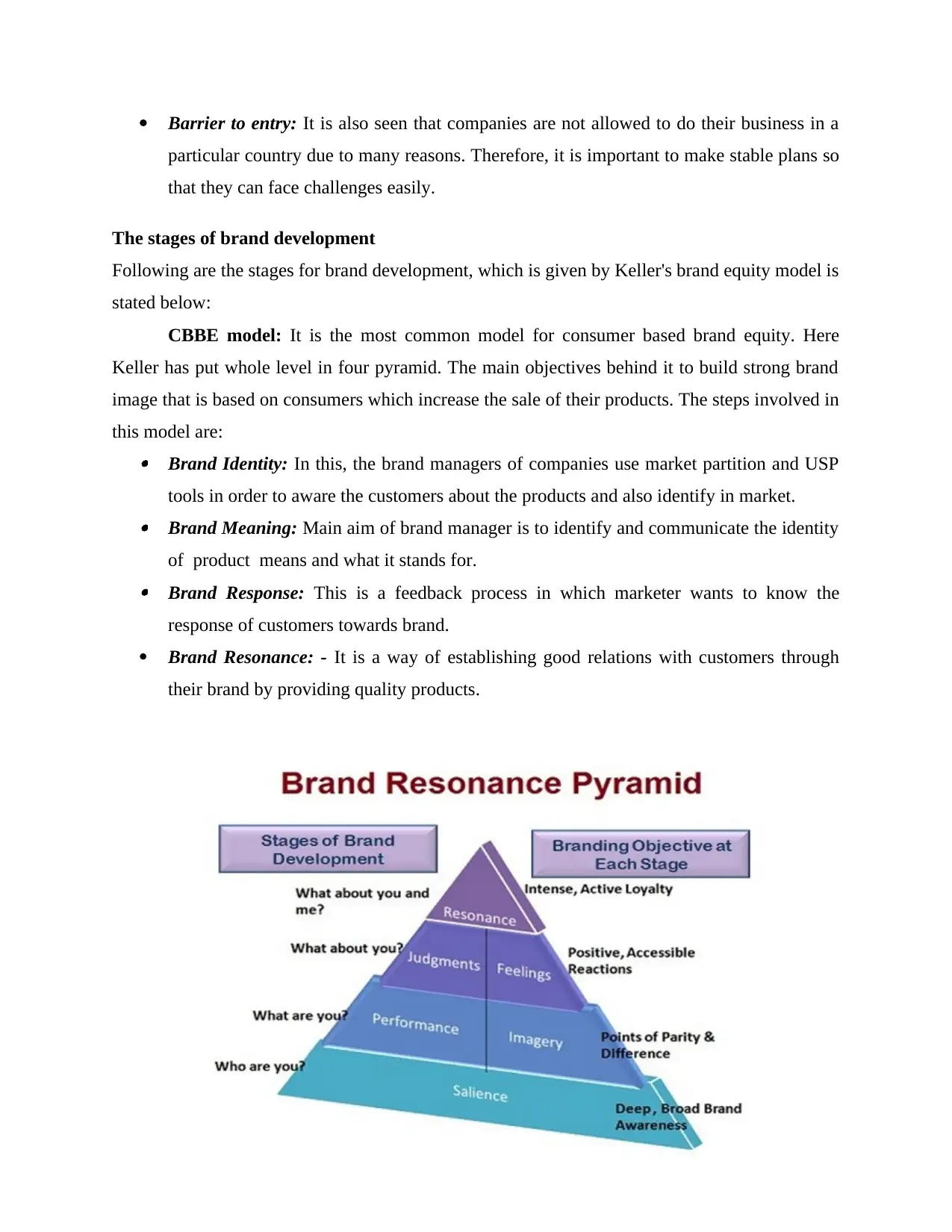
Barrier to entry: It is also seen that companies are not allowed to do their business in a
particular country due to many reasons. Therefore, it is important to make stable plans so
that they can face challenges easily.
The stages of brand development
Following are the stages for brand development, which is given by Keller's brand equity model is
stated below:
CBBE model: It is the most common model for consumer based brand equity. Here
Keller has put whole level in four pyramid. The main objectives behind it to build strong brand
image that is based on consumers which increase the sale of their products. The steps involved in
this model are: Brand Identity: In this, the brand managers of companies use market partition and USP
tools in order to aware the customers about the products and also identify in market. Brand Meaning: Main aim of brand manager is to identify and communicate the identity
of product means and what it stands for. Brand Response: This is a feedback process in which marketer wants to know the
response of customers towards brand.
Brand Resonance: - It is a way of establishing good relations with customers through
their brand by providing quality products.
particular country due to many reasons. Therefore, it is important to make stable plans so
that they can face challenges easily.
The stages of brand development
Following are the stages for brand development, which is given by Keller's brand equity model is
stated below:
CBBE model: It is the most common model for consumer based brand equity. Here
Keller has put whole level in four pyramid. The main objectives behind it to build strong brand
image that is based on consumers which increase the sale of their products. The steps involved in
this model are: Brand Identity: In this, the brand managers of companies use market partition and USP
tools in order to aware the customers about the products and also identify in market. Brand Meaning: Main aim of brand manager is to identify and communicate the identity
of product means and what it stands for. Brand Response: This is a feedback process in which marketer wants to know the
response of customers towards brand.
Brand Resonance: - It is a way of establishing good relations with customers through
their brand by providing quality products.
Paraphrase This Document
Need a fresh take? Get an instant paraphrase of this document with our AI Paraphraser
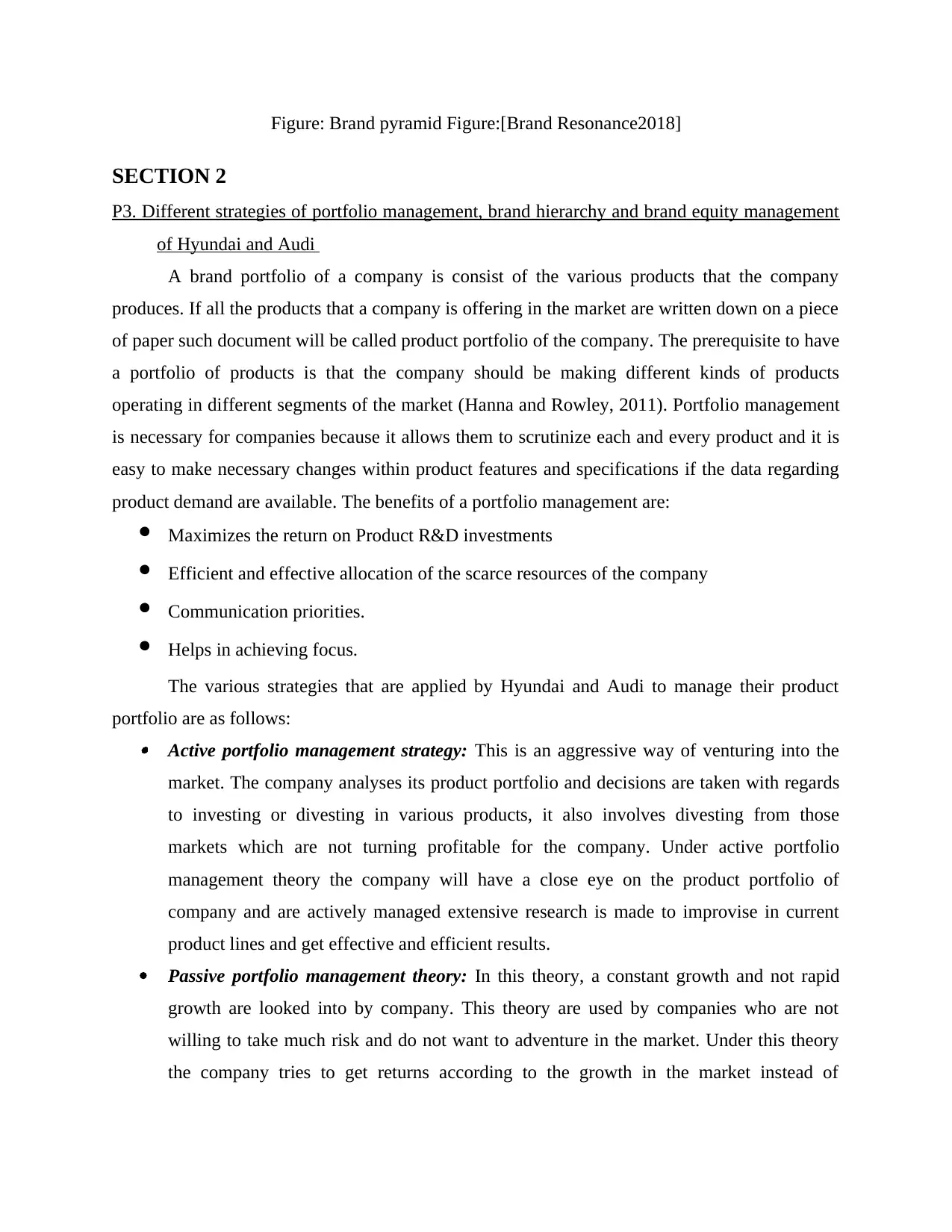
Figure: Brand pyramid Figure:[Brand Resonance2018]
SECTION 2
P3. Different strategies of portfolio management, brand hierarchy and brand equity management
of Hyundai and Audi
A brand portfolio of a company is consist of the various products that the company
produces. If all the products that a company is offering in the market are written down on a piece
of paper such document will be called product portfolio of the company. The prerequisite to have
a portfolio of products is that the company should be making different kinds of products
operating in different segments of the market (Hanna and Rowley, 2011). Portfolio management
is necessary for companies because it allows them to scrutinize each and every product and it is
easy to make necessary changes within product features and specifications if the data regarding
product demand are available. The benefits of a portfolio management are:
Maximizes the return on Product R&D investments
Efficient and effective allocation of the scarce resources of the company
Communication priorities.
Helps in achieving focus.
The various strategies that are applied by Hyundai and Audi to manage their product
portfolio are as follows: Active portfolio management strategy: This is an aggressive way of venturing into the
market. The company analyses its product portfolio and decisions are taken with regards
to investing or divesting in various products, it also involves divesting from those
markets which are not turning profitable for the company. Under active portfolio
management theory the company will have a close eye on the product portfolio of
company and are actively managed extensive research is made to improvise in current
product lines and get effective and efficient results.
Passive portfolio management theory: In this theory, a constant growth and not rapid
growth are looked into by company. This theory are used by companies who are not
willing to take much risk and do not want to adventure in the market. Under this theory
the company tries to get returns according to the growth in the market instead of
SECTION 2
P3. Different strategies of portfolio management, brand hierarchy and brand equity management
of Hyundai and Audi
A brand portfolio of a company is consist of the various products that the company
produces. If all the products that a company is offering in the market are written down on a piece
of paper such document will be called product portfolio of the company. The prerequisite to have
a portfolio of products is that the company should be making different kinds of products
operating in different segments of the market (Hanna and Rowley, 2011). Portfolio management
is necessary for companies because it allows them to scrutinize each and every product and it is
easy to make necessary changes within product features and specifications if the data regarding
product demand are available. The benefits of a portfolio management are:
Maximizes the return on Product R&D investments
Efficient and effective allocation of the scarce resources of the company
Communication priorities.
Helps in achieving focus.
The various strategies that are applied by Hyundai and Audi to manage their product
portfolio are as follows: Active portfolio management strategy: This is an aggressive way of venturing into the
market. The company analyses its product portfolio and decisions are taken with regards
to investing or divesting in various products, it also involves divesting from those
markets which are not turning profitable for the company. Under active portfolio
management theory the company will have a close eye on the product portfolio of
company and are actively managed extensive research is made to improvise in current
product lines and get effective and efficient results.
Passive portfolio management theory: In this theory, a constant growth and not rapid
growth are looked into by company. This theory are used by companies who are not
willing to take much risk and do not want to adventure in the market. Under this theory
the company tries to get returns according to the growth in the market instead of
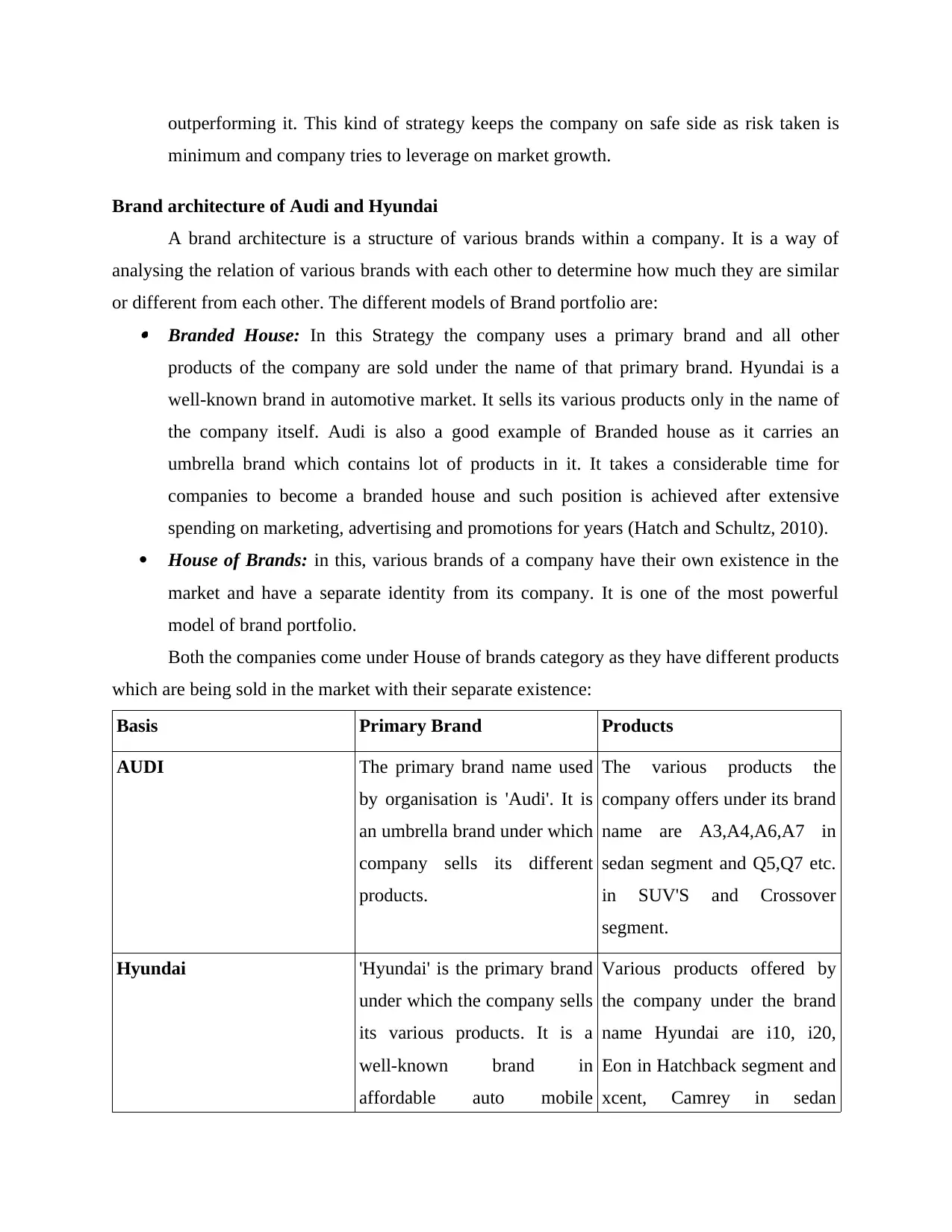
outperforming it. This kind of strategy keeps the company on safe side as risk taken is
minimum and company tries to leverage on market growth.
Brand architecture of Audi and Hyundai
A brand architecture is a structure of various brands within a company. It is a way of
analysing the relation of various brands with each other to determine how much they are similar
or different from each other. The different models of Brand portfolio are: Branded House: In this Strategy the company uses a primary brand and all other
products of the company are sold under the name of that primary brand. Hyundai is a
well-known brand in automotive market. It sells its various products only in the name of
the company itself. Audi is also a good example of Branded house as it carries an
umbrella brand which contains lot of products in it. It takes a considerable time for
companies to become a branded house and such position is achieved after extensive
spending on marketing, advertising and promotions for years (Hatch and Schultz, 2010).
House of Brands: in this, various brands of a company have their own existence in the
market and have a separate identity from its company. It is one of the most powerful
model of brand portfolio.
Both the companies come under House of brands category as they have different products
which are being sold in the market with their separate existence:
Basis Primary Brand Products
AUDI The primary brand name used
by organisation is 'Audi'. It is
an umbrella brand under which
company sells its different
products.
The various products the
company offers under its brand
name are A3,A4,A6,A7 in
sedan segment and Q5,Q7 etc.
in SUV'S and Crossover
segment.
Hyundai 'Hyundai' is the primary brand
under which the company sells
its various products. It is a
well-known brand in
affordable auto mobile
Various products offered by
the company under the brand
name Hyundai are i10, i20,
Eon in Hatchback segment and
xcent, Camrey in sedan
minimum and company tries to leverage on market growth.
Brand architecture of Audi and Hyundai
A brand architecture is a structure of various brands within a company. It is a way of
analysing the relation of various brands with each other to determine how much they are similar
or different from each other. The different models of Brand portfolio are: Branded House: In this Strategy the company uses a primary brand and all other
products of the company are sold under the name of that primary brand. Hyundai is a
well-known brand in automotive market. It sells its various products only in the name of
the company itself. Audi is also a good example of Branded house as it carries an
umbrella brand which contains lot of products in it. It takes a considerable time for
companies to become a branded house and such position is achieved after extensive
spending on marketing, advertising and promotions for years (Hatch and Schultz, 2010).
House of Brands: in this, various brands of a company have their own existence in the
market and have a separate identity from its company. It is one of the most powerful
model of brand portfolio.
Both the companies come under House of brands category as they have different products
which are being sold in the market with their separate existence:
Basis Primary Brand Products
AUDI The primary brand name used
by organisation is 'Audi'. It is
an umbrella brand under which
company sells its different
products.
The various products the
company offers under its brand
name are A3,A4,A6,A7 in
sedan segment and Q5,Q7 etc.
in SUV'S and Crossover
segment.
Hyundai 'Hyundai' is the primary brand
under which the company sells
its various products. It is a
well-known brand in
affordable auto mobile
Various products offered by
the company under the brand
name Hyundai are i10, i20,
Eon in Hatchback segment and
xcent, Camrey in sedan
⊘ This is a preview!⊘
Do you want full access?
Subscribe today to unlock all pages.

Trusted by 1+ million students worldwide
1 out of 18
Related Documents
Your All-in-One AI-Powered Toolkit for Academic Success.
+13062052269
info@desklib.com
Available 24*7 on WhatsApp / Email
![[object Object]](/_next/static/media/star-bottom.7253800d.svg)
Unlock your academic potential
Copyright © 2020–2025 A2Z Services. All Rights Reserved. Developed and managed by ZUCOL.





